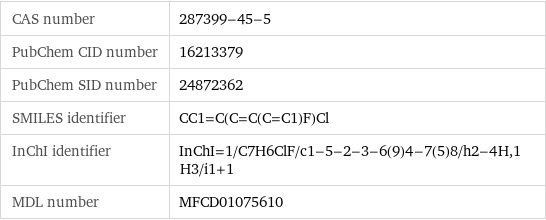Input interpretation

2-chloro-4-fluorotoluene-α-13 C
Chemical names and formulas

formula | ^13CH_3C_6H_3(Cl)F Hill formula | C_6(13C)H_6ClF name | 2-chloro-4-fluorotoluene-α-13 C IUPAC name | 2-chloro-4-fluoro-1-methylbenzene alternate names | 2-chloro-4-fluoro-1-methyl-benzene | 2-chloro-4-fluoro-1-methylbenzene mass fractions | Cl (chlorine) 0.244% | F (fluorine) 0.131% | C (carbon) 0.584% | H (hydrogen) 0.0415%
Lewis structure

Draw the Lewis structure of 2-chloro-4-fluorotoluene-α-13 C. Start by drawing the overall structure of the molecule, ignoring potential double and triple bonds: Count the total valence electrons of the carbon (n_C, val = 4), chlorine (n_Cl, val = 7), fluorine (n_F, val = 7), and hydrogen (n_H, val = 1) atoms: 7 n_C, val + n_Cl, val + n_F, val + 6 n_H, val = 48 Calculate the number of electrons needed to completely fill the valence shells for carbon (n_C, full = 8), chlorine (n_Cl, full = 8), fluorine (n_F, full = 8), and hydrogen (n_H, full = 2): 7 n_C, full + n_Cl, full + n_F, full + 6 n_H, full = 84 Subtracting these two numbers shows that 84 - 48 = 36 bonding electrons are needed. Each bond has two electrons, so in addition to the 15 bonds already present in the diagram add 3 bonds. To minimize formal charge carbon wants 4 bonds. Identify the atoms that want additional bonds and the number of electrons remaining on each atom: Fill in the 3 bonds by pairing electrons between adjacent highlighted atoms. Note that the six atom ring is aromatic, so that the single and double bonds may be rearranged: Answer: | |
Basic properties

molar mass | 145.6 g/mol phase | liquid (at STP) boiling point | 155 °C density | 1.205 g/cm^3
Units

Liquid properties (at STP)

density | 1.205 g/cm^3 refractive index | 1.499
Units

Non-standard atom properties

C-13 | 1
Chemical identifiers

CAS number | 287399-45-5 PubChem CID number | 16213379 PubChem SID number | 24872362 SMILES identifier | CC1=C(C=C(C=C1)F)Cl InChI identifier | InChI=1/C7H6ClF/c1-5-2-3-6(9)4-7(5)8/h2-4H, 1H3/i1+1 MDL number | MFCD01075610
Safety properties

flash point | 50 °C